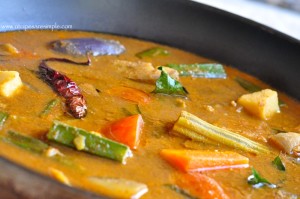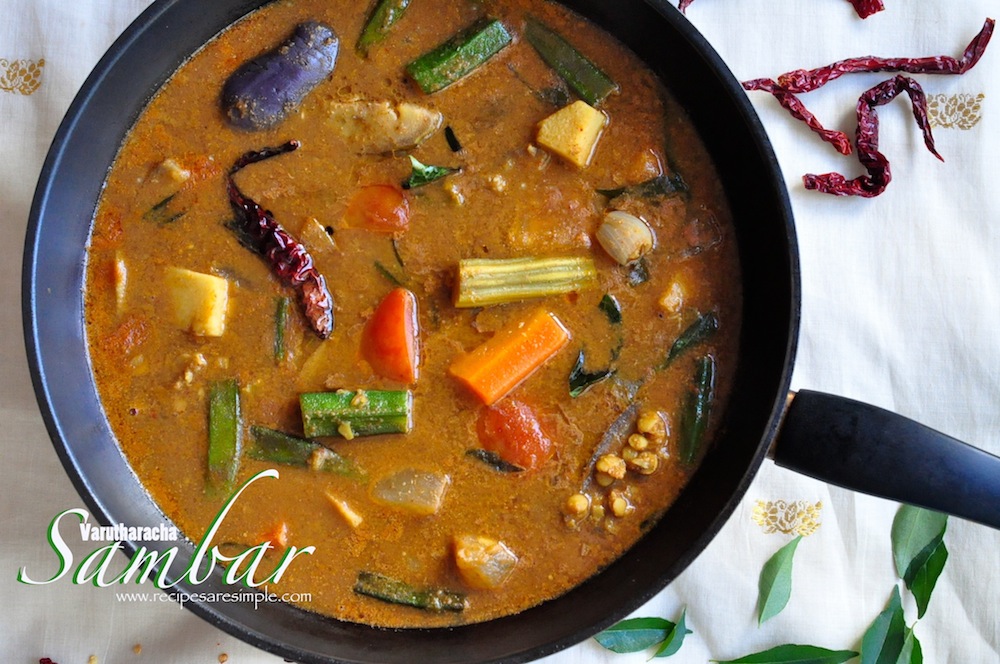Varutharacha Sambar
Kerala Sambar made with traditional roasted, ground spice and coconut paste.
The Recipe Intro↓ has , more information, step-wise images , related links as well as the Recipe Video. Don’t forget to check it out.

Ingredients:
| Tur dal ( pigeon peas) | ½ cup | |
| Turmeric powder | ½ tsp | |
| Large potato - peeled, cut into 6 large chunky pieces | 1 | |
| Small carrot, peeled and cut into 1½ " lengths | 1 | |
| Small eggplants, cut into four pieces | 2 | |
| Small plantain (raw) - skin scraped (not peeled), cut into chunks | ¾ | |
| Drumstick - the vegetable folks 🙂 , scraped (not peeled) | 1 | |
| Elephant yam, cubes | ½ cup | |
| Winter melon (ash gourd), cubed | ½ cup | |
| Shallots, peeled and left whole | 6-7 | |
| Ladies fingers (okra), cut into 1½ " pieces | 4-5 | |
| Large tomato, chopped | 1 | |
| Small green chillies (slit through the middle and seeds removed if needed) | 3 - 5 | |
| Fresh curry leaves | Small handful | |
| Tamarind pulp (soaked in hot water for 20 minutes) | 1 lime sized ball | |
| Coconut oil (authentic) or oil of choice | 3 Tbsp | |
| Salt | To taste | |
| Fresh coriander leaves , chopped | Handful |
For the special roasted Varutharacha Sambar Masala powder:
| Fresh grated coconut, loosely packed | ¾ cup | |
| Whole coriander seeds | 1 ¾ Tbsp | |
| Urad dal (black gram dal) | 1 Tbsp | |
| Chana dal ( bengal gram dal) | 1 Tbsp | |
| Long dried red chillies (the milder variety) | 5 | |
| Fenugreek seeds | ¹/8 tsp | |
| Asafoetida ( crushed using mortar and pestle) | 1 small piece |
For tempering:
| Dried red chillies, broken | 1- 2 | |
| Fenugreek seeds | ¼ tsp | |
| Curry leaves | A sprig |
Method:
- Leave the tamarind pulp in hot water to soften before you start.
- Peel, scrape, and chop all the vegetables as specified (see notes).
- Add the vegetables to a bowl of water to prevent any discoloration.
- Rinse the Pigeon peas ( tur dal ). Add to a large pressure cooker with turmeric powder and ½ tsp salt. Pressure cook for 1 steam whistle on medium heat. Turn off the heat. Leave the cooker to cool on its own.
- Remove half the dal to a bowl. Leave the rest as well as the broth in which it was cooked in the pressure cooker.
- To this add all vegetables except ladies fingers and tomatoes. Add another tsp of salt or so.
- Pressure cook again on medium heat for a single steam whistle. However this time we will release the steam manually. (Place the cooker under running water, till you can open the cooker). This prevents overcooking the vegetables, causing them to get mashed. Set aside.
- To a dry pan or wok: add the coriander seeds, dried red chilli, urad dal, chana dal, fenugreek seeds followed by the coconut. Roast, stirring continuously. Add the Asafoetida. Roast till the coconut is toasted and golden brown. Do not allow any blackening of the spices or coconut. If this occurs, throw it out and start again. Don’t try to make it work. Trust me
- Add the roasted ingredients to a small heat-proof grinder ( or wait till it cools down). Grind with just a little water to a paste. (As smoothly as possible).
- Add to the vegetables and bring to a simmer: allow the raw smells to dissipate. Also, return the reserved cooked dal. Allow to simmer and thicken. Taste and add salt if needed.
- In another wide-mouthed pan or wok, heat some of the oil. Add the okra and stir fry a bit till deep green in color.
- Add the curry leaves and the chopped tomato. Cook down till the tomatoes are softened and the okra is cooked tender.
- Add the entire cooked dal and vegetable mixture (from the pressure cooker) to the pan.
- Add the tamarind solution and allow to simmer shortly.
- Temper: Heat the remaining oil in a small pan. Add the fenugreek seeds allow to crackle. Add dried chilli and curry leaves. When aromatic and fried, add to the curry.
- Add chopped fresh coriander leaves over the Sambar and serve hot.

Varutharacha Sambar
Notes:
- When chopping, cutting vegetables for the Sambar, it is important to remember that the different vegetables are cooked differently, and that is why we keep the pieces on the larger side. Don’t cop the vegetables too small. Traditionally vegetables like carrot, ladies fingers, drumsticks, plantain are cut into finger length, thick pieces. Potatoes, eggplant, are cut into big squarish – chunks, and winter melon, elephant yam are cut into squarish cubes . etc.
- Half of the dal is removed in his recipe prior to cooking the vegetables with rest of the dal. The reason for this is to keep some texture and bite to some of the dal while mashing up the rest in the final dish.
- When grinding the roasted coconut mixture, traditionally a stone grinder is used. The taste is improved.
- Fresh Asafoetida always gives better flavor but if you only have powdered form, use that.
- Read more about the origination of the Sambar dish.
Key Ingredients: Mixed Sambar vegetables, Shallots, Coconut, Dals, Spices, Tamarind, Coconut Oil, Salt, Curry Leaves, Coriander Leaves.
EAT AND TELL!!! Let us know if you tried – Varutharacha Sambar
Mail me your pics and testimonials 🙂 – recipesaresimple@gmail.com


